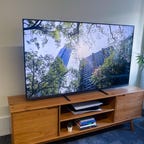

Why You Can Trust CNET

Affordable option with 4K 120Hz and VRR
Vizio MQX series (Temporarily out of Stock)
TVs are no longer used just for watching movies or TV shows. The use cases of TVs have changed over the years, and most people purchasing a new TV these days will have several other factors to consider These include things like whether the new TV will be compatible with their gaming setup. These TVs usually boast a number of great gaming features, such as HDMI 2.1’s 120Hz and low-latency support. Any TV with an HDMI port will be compatible with a PS5, Xbox Series X, and Xbox Series S console, but it won’t be able to take advantage of the full potential of any of these modern consoles.
The best 4K TVs these days are equipped with HDMI 2.1 ports, which have the power to let you play at 4K with HDR and reach frame rates as high as 120 frames per second. On top of all that, the gameplay stays butter-smooth, with the consoles and TV playing nice via variable refresh rate, which reduces choppy movement and screen tearing for solid picture quality.
The good news is that you don’t have to spend a fortune on an 88-inch 8K behemoth to get these gaming console-friendly features. In fact, you can find most of the features necessary for an excellent gaming experience, including 4K 120Hz and VRR, in 50-inch TVs at $600 or less and 65-inch models for less than $1,000.
What is the best TV for PS5 and Xbox right now?
LG’s C2 may be on the expensive side, but it pairs high-end image quality with impressive gaming features on every input. All of the TV’s HDMI ports include the latest version of the HDMI standard: 2.1. That means its HDMI ports can handle 4K at 120 frames per second and variable refresh rate (including Nvidia G-Sync and AMD FreeSync), as well as enhanced audio return channel and automatic low latency mode (auto game mode). In other words, it can take advantage of the latest graphics features available from PlayStation 5 and Xbox Series X and S consoles as well as high-end graphics cards. The C2 is rare among high-end TVs in that all four of its HDMI ports support 4K/120 — great for hard-core gamers with multiple next-gen devices. The TV also comes with a specialized Game Optimizer settings suite. It’s a great choice for gamers who want an excellent picture and aren’t afraid to splurge to get it.
Best TVs for PS5 and Xbox of 2023
Whether you’re looking for the best TV for PS5 gaming, Xbox Series X or S or another next-gen console, here are our current favorite gaming TV options. Unless otherwise noted all of the prices listed are for 65-inch sizes, but every series is available in other sizes, too.
Show less
LG’s C2 offers some of the best TV image quality we’ve tested, comes in a variety of sizes and includes the full range of gaming features on every input. The C2 represents the pinnacle of picture quality, at a price that’s admittedly high but not too crazy. It beats any non-OLED TV on this list, including the Samsung QN90B below, with its perfect black levels, unbeatable contrast and superb off-angle viewing. It also has excellent gaming features, making it a great companion to an Xbox Series X or S, PlayStation 5 or both. The C2 comes in a variety of sizes as well, though the bigger models are expensive.
The C2 is also one of the lightest TVs we’ve ever reviewed thanks to carbon-fiber construction. The 65-inch version weighs just 37 pounds with its stand, compared with 72 pounds for the 65-inch C1 from last year.
Pros:
- Better picture quality than any non-OLED TV
- Superior contrast and off-angle image
- Best-in-class gaming features
- Sleek styling with ultralight, thin panel
Cons:
- Expensive
- No major picture quality improvements over the C1 from 2021
The C1 was also an excellent TV that delivered similar image quality and features to the C2. We’ve also reviewed the 2023 version, the LG C3, but we recommend the C2 instead right now. Going with last year’s LG OLED saves you a few hundred bucks and the two TVs were basically indistinguishable in features, design and image quality in my tests. The C2 will sell out over the summer and heading into the TV buying season this fall, while the C3 will drop in price, but if you want a high-end TV right now, grab a C2.
Show expert take Show less
Editors’ choice
Show less
Our favorite TV overall for the money happens to be an excellent gaming TV as well. This TCL supports all the high-end gaming extras you expect, including 4K, 120Hz input and variable refresh rate. Our tests of its gaming picture revealed excellent overall quality, in particular shadow detail.
This TV has an excellent image thanks to mini-LED tech and well-implemented full-array local dimming that helps it run circles around just about any other TV at this price. It improves upon the previous R635 series with improved gaming extras and a new center-mount stand that you can elevate to make room for a soundbar, although the new 85-inch size has standard legs. And finally, the Roku TV operating system is our hands-down favorite.
Pros:
- Relatively affordable
- Excellent overall image quality
- Roku smart TV is simple, capable
- Improved design with central stand
Cons:
- Some competing mini-LED TVs can get brighter
Note that in addition to the R635, which this TV replaces, other versions of the 6-Series were released in 2021 and remain on sale. The R646 series uses the Google TV operating system but otherwise has similar specifications to the R655 models reviewed here. The R648 series has 8K resolution and is significantly more expensive.
Show expert take Show less
Show less
In our review of the Hisense we rated its overall image quality nearly as good as the TCL, and we actually liked its gaming picture a bit better, thanks to punchier highlights. It comes in second to the TCL with worse lag, but most people won’t notice the extra 5 milliseconds. Gamers can’t go wrong with either one.
Its excellent image quality is anchored by best-in-class brightness that improves its bright-room picture quality and makes HDR TV movies, shows and games really pop. It’s actually brighter than the TCL with better contrast, but the TCL’s slightly more accurate image gave it the edge overall. The Hisense uses Google TV instead of Roku, and unlike the TCL, the U8H includes an ATSC 3.0 tuner. Frankly, you can’t go wrong with either one.
Pros:
- Relatively affordable
- Excellent overall image quality
- Best-in-class bright room picture
- Capable Google TV system
Cons:
- Slightly less refined image than some competitors
- “Theater” picture modes engage motion smoothing by default
This is a 2022 model, but the 2023 version, the U8K series, looks largely similar aside from the addition of a 75-inch option. We haven’t reviewed it yet. It’s currently a couple of hundred dollars more expensive than the U8H.
Show expert take Show less
Show less
The Vizio V-Series costs hundreds less than any of the TVs above, its image quality can’t compete, and it lacks 4K, 120Hz input, but for a budget model its gaming chops are top-notch. It’s the only budget TV we’ve seen that supports variable refresh rate, and its overall image quality was a cut above similarly priced models from TCL, Hisense and others.
Pros:
- Solid image quality for en entry-level TV
- Lots of features including VRR and Wi-Fi 6E
Cons:
- Poor built-in smart TV system
Vizio hasn’t announced a 2023 version of the V-Series yet.
The price shown below is for the 65-inch size.
Show expert take Show less
Show less
With a price generally lower than any of the TVs above, this Vizio’s image quality and gaming features aren’t quite as good, but it’s still a solid step above budget gaming TVs. Local dimming achieves solid contrast and the MQX has both 4K/120Hz input capability and VRR, which are rare at this price.
Pros:
- Affordable
- Excellent picture quality
- Game-friendly extras like variable refresh rate and 4K/120Hz input
Cons:
- Weak smart TV system
- Slightly more-expensive TVs perform better
Unlike the M7 from 2021, the MQX has a true 120Hz refresh rate, which allows compatibility with 4K/120Hz signals from game consoles like the Xbox Series X and PlayStation 5, and it worked well in our tests. Vizio supports both major HDR formats, HDR10 and Dolby Vision, in the M-Series. If you can’t save up for the TCL or the Hisense but want a better picture than the TCL 4-Series or Vizio V-series, the Vizio MQX is an excellent happy medium.
Vizio hasn’t announced a 2023 version of this TV.
Show expert take Show less
Our TV reviews follow a rigorous, unbiased evaluation process honed over nearly two decades of TV reviews. Our primary TV test lab has specialized equipment for measuring light and color, including a Konica Minolta CS-2000 spectroradiometer, a Murideo Sig-G 4K HDR signal generator and an AVPro Connect 8×8 4K HDR distribution matrix. We use Portrait Displays CalMan Ultimate software to evaluate every TV we review. In every CNET TV review, three or more similar TVs are compared side by side in various lighting conditions playing different media, including movies, TV shows and games, across a variety of test categories, from color to video processing to gaming to HDR. Our reviews also account for design, features, smart TV performance, HDMI input and gaming compatibility, as well as other factors.
One important aspect of image quality we test is overall brightness. Here’s how it compares in nits across select TVs listed above.
Light output in nits
undefined
| TV | Brightest mode (HDR) | Accurate mode (HDR) | Brightest mode (SDR) | Accurate mode (SDR) |
|---|---|---|---|---|
| Samsung QN65Q90B | 3,316 | 1,981 | 2,625 | 974 |
| Hisense U8H | 1,867 | 1,867 | 1,605 | 1,605 |
| TCL 65R655 | 1,387 | 1,194 | 1,292 | 624 |
| Vizio M65QXM-K03 | 939 | 742 | 958 | 608 |
| LG OLED65C2 | 812 | 759 | 413 | 389 |
| Roku TV Plus (65-inch) | 514 | 455 | 579 | 404 |
Check out How We Test TVs for more details.
With all of the TVs available today, and all of the technical terms and jargon associated with television technology, it can be tough to figure out what’s important. Here’s a quick guide to help cut through the confusion.
Price: TVs range in price from $100 to more than $2,000. Smaller screens are cheaper, well-known brands are more expensive and spending more money can also get you better image quality. Most entry-level TVs have a good enough picture for most people, but TVs last a long time, so it might be worth spending more to get a better picture. It’s also best to shop for a TV in the fall, when prices are lower.
Screen size: Bigger is better in our book. We recommend a size of at least 43 inches for a bedroom TV and at least 55 inches for a living room or main TV — and 65 inches or larger is best. More than any other “feature,” stepping up in TV screen size is the best use of your money. One of the most common post-TV-purchase complaints we’ve heard is from people who didn’t go big enough. And we almost never hear people complain that their TV is too large.
Capability: Among entry-level TVs the most important feature is what kind of smart TV system the TV uses. Among midrange models, look for a feature including full-array local dimming, mini-LED and 120Hz refresh rate, which (unlike some other extras) do help improve the picture in our experience. And among high-end TVs, OLED technology is your best bet.
For more TV buying advice check out How to Buy a TV.
What TVs support HDMI 2.1 features?
What is ALLM or Game mode?


